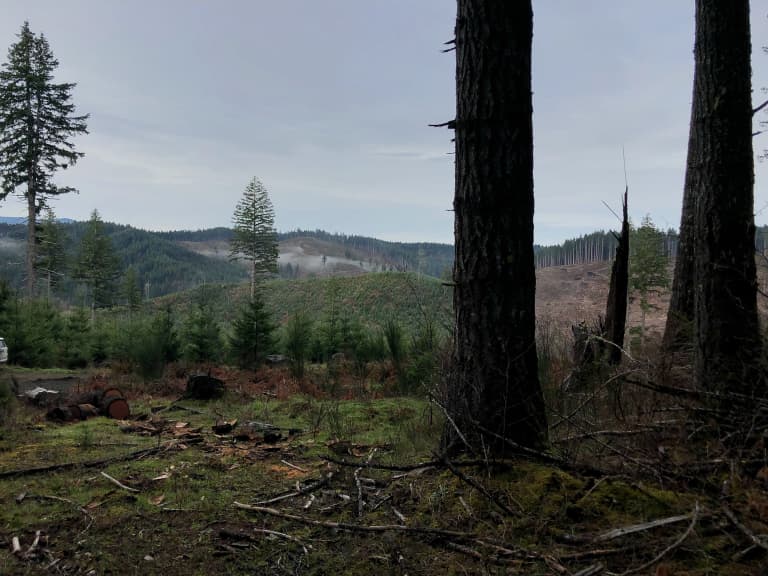Some paths around Spirit Mountain near Grand Ronde, Ore. are only wide enough for one truck, a reminder that looms ominous as vehicles slow to manage the road’s tighter turns. The juxtaposition, however, is breathtaking. The steep drops from the dirt’s edge feed into swathes of woodlands, providing the perfect vistas to scan the green, brown and grey towers that form their constellations amid overcast horizons. Their forests rest, in contrast, against acres of newly planted trees, as well as the area’s newest clear-cut fields.
“The bees have been taking it in the shorts,” David Hampton explains, telling his traveling crew what he does with their newly cleared land. Typically, in the timber industry, cut trees are replanted, and a cycle of patience ensues. But Hampton Lumber doesn’t just replant trees, he says. They do so at a four-to-one ratio, and in these vacated spaces, the “clear cuts,” they have begun planting fields of wildflowers, giving the space additional purpose as forests mature.
“Clear cuts are good for the pollinators,” Hampton says, knowing that the world’s bees need help.
Hampton’s crew on this day, one week before the Portland Timbers’ home opener, is a special one. In the back seats of his Ford Super Duty FX4 sit Timber Jim and Timber Joey, whose annual mission to find the team’s Victory Log has brought them to the mountain. In the coming hours, the team will identify, cut and prepare the logs that will be used through the 2018 season, cut slab by slab in Providence Park’s north end as the Timbers accumulate clean sheets and goals. Before then, the log will go through a rite of passage at Camp 18 Restaurant in Elsie, Oregon, where it will be blessed by Timbers Army members before being transported to Portland.

That, though, is still some ways off. As Hampton drives deeper into his family’s property, you see the generations of work that have gone into organizing the land. It’s marked not only in the height and the health of the land’s timber but also the prominence of it. While the Hampton Family Forest is, in a technical sense, a place of work – a place of business – those artifacts are the subtext to area’s natural arc. The road, the truck, and the tools the crews brought are humanity’s only roles in this plot.
At least, that’s what the eye says. In truth, maintaining these woods in a natural, sustainable way has been a decidedly human effort, one the Hamptons embarked on centuries ago, and one the family’s business has embraced at its core.
“That my grandfather and later, my father planted the trees that now cover this area really shows the long-term, sustainable nature of the wood products business,” Hampton says. “When I harvest a tree for one of our mills, I plant four in its place so that decades from now, my children can do the same.”
Hampton reiterated those ideals at the log blessing, when he talked about the wood used to build Area 18, as well as the long-term, environmental value of fostering wood. They’re the same values that are in focus as the Victory Log search reaches the deepest part of the Hampton Family Forests, eventually stopped at an area just short of one of the land’s running hills.
To the untrained eye, there are 10, maybe 15 candidates in view. But Timbers Jim and Joey, as well as Hampton as his friend, Ken Risseeuw, quickly focus on two or three near the foot of the hill. Eventually, the group picks out the one closest to the road, testing it briefly before Risseeuw prepares his chainsaw.

The first cut is horizontal, 180 degrees to the ground, cutting through roughly 80 percent of the tree’s width and leaving the trunk comfortably on its base. The next cut, though – angled into the end of the first, about 30 degrees down from it – fells the log, sending the tree crashing just short of a small grove across the road.
Soon, the tree is quartered, with few slabs immediately cut from the base. Some scheduled to be given away, for posterity; others will be auctioned for charity. From one, though, the group counts the rings, allowing them to come to grips with the structure that just fell. This year’s logs – four, ten-foot pieces, ultimately – came from a tree that had reached 80 years old.
Soon, the first of this year’s logs is at Area 18, with near 100 people at the meal surrounding this year’s blessing. It’s an annual tradition among supporters, a ceremony that sees fans link up with and around the log while a traditional Irish prayer is recited by the group. “May your home be strong of beam,” they begin, in unison, heads bowed while hands rest on the log or each other’s shoulders.
Before the log is driven home, the final part of the tradition plays out, with a small group taking to the space around Area 18 to plant trees of their own. Amid the saplings committed to soil this weekend, you see, in the surrounding patches, the staged growth of rituals paths. From the surroundings’ smallest trees to its largest, step by step, you see the climb the ritual has make from its beginnings years ago.
Come Saturday, that new log will be on hand in the north end, there for all of Providence Park to celebrate as the year begins. If the year plays out as planned, all four of this years’ logs will be spent before the season’s done. But as they’re spent, a series of new trees will grow, and 80 years from now, when the tradition plays out once more, one of this year’s saplings could be the next Victory Log.










